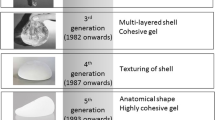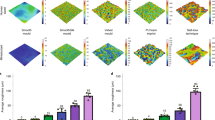Abstract
Breast implants are applied to correct the size, form, and feel of a woman’s breasts in post-mastectomy breast reconstruction, for correcting congenital defects and deformities of the chest wall, for aesthetic breast augmentation, and for creating breasts in the male-to-female transsexual patient. The most widely applied silicone implants have an elastomer silicone shell filled with viscous silicone gel. It has become increasingly clear that it is important for plastic surgeons to know and to provide patients with the latest information on silicone breast implants. This article was therefore written to provide more insight into the composition of silicone breast implants and their characteristics. After describing the chemical properties of silicones and silicone implants, gel bleeding and the consequences of aging of silicone implants will be discussed. The information provided can also give a hint as to why silicone implants have been consistently implicated in health issues ever since the late 1960s.
Level of Evidence: Not ratable.

Similar content being viewed by others
References
Kroschwitz JI, Howe-Grant M (1997) Kirk Othmer Encyclopedia of Chemical Technology, Volume 22, Silicon Compounds, 4th edn. John Wiley & Sons, New York
Le Vier RR, Harrison M, Cook R et al (1992) What is silicone? Plast Reconstr Surg 92:163–167
Kossovsky N, Heggars JP (1987) The bioreactivity of silicone. Crit Rev Biocompat 3:53–85
Batich C, De Palma D, Marotta J et al (1996) Silicone degradation reactions. Curr Top Microbiol Immunol 210:13–23
Lane TH, Burns SA (1996) Silica, silicon and silicones … unraveling the mystery. Curr Top Microbiol Immunol 210:3–12
Rochow EG (1987) Silicon and silicones: about stone-age tools, antique pottery, modern ceramics, computers, space materials and how they all got that way. Springer, Berlin, Heidelberg
Kinrade SD, Gillson AME, Knight CTG (2002) Silicon-29 NMR evidence of a transient hexavalent silicon complex in the diatom Navicula pelliculosa. J Chem Soc Dalton Trans 3:307–309
Friedel C, Crafts JM (1863) Sur quelques nouvelles combinations organiques du silicium et sur le poids atomique de cet element. Compte Rendu 56:592
Kipping FS (1907) Organic derivatives of silicone. II. The synthesis of benzylethylpropysilicol, its sulfonation and resolution of the D-L derivatives into its optically active component. J Chem Soc 91:209
Rowe VK, Spencer SC, Bass SL (1948) Toxicological studies on certain commercial silicone and hydrolizable silane intermediates. J Ind Hyg 30:332
Rowe VK, Spencer SC, Bass SL (1950) Toxicologic studies on certain commercial silicones. Arch Ind Hyg Med 1:539–544
Reams BD (1992) Transcripts of the panel meeting on the topic of silicone gel-filled breast implants. William S Hein & Co, Buffalo, NY
Environ corporation (1991) Evaluation of the safety of silicone gel-filled breast prostheses. Report prepared for McGhan Medical Corporation
Barr S, Bayat A (2011) Breast implant surface development: perspectives on development and manufacture. Aesthet Surg J 31:56–67
Yu LT, Latorre G, Marotta J et al (1996) In vitro measurement of silicone bleed from breast implants. Plast Reconstr Surg 97:756–764
Beekman WH, Feitz R, Van Diest PJ et al (1997) Migration of silicone through the fibrous capsules of mammary prostheses. Ann Plast Surg 38:441–445
Barker DE, Retsky MI, Schultz S (1978) “Bleeding” of silicone from bag-gel breast implants, and its clinical relation to fibrous capsule reaction. Plast Reconstr Surg 61:836–841
Truong LD, Cartwright J, Goodman MD et al (1988) Silicone lymphadenopathy associated with augmentation mammaplasty, morphologic features of nine cases. Am J Surg Pathol 12:484–491
Brody GS (1997) On the safety of breast implants. Plast Reconstr Surg 100:1314–1321
Spear S (2006) The breast implant story. Ann Plast Surg 56:573–583
Bergman RB, van der Ende AE (1979) Exudation of silicone through the envelope of gel-filled breast prostheses: an in vitro study. Br J Plast Surg 32:31–34
Van Diest PJ, Beekman WH, Hage JJ (1998) Pathology of silicone leakage from breast implants. J Clin Pathol 51:493–497
Hausner RJ, Schoen FJ, Mendez-Fernandez MA et al (1981) Migration of silicone gel to axillary lymph nodes after prosthetic mammoplasty. Arch Pathol Lab Med 105:371–372
Wintsch W, Smahel J, Clodius L (1978) Local and regional lymph node response to ruptured gel-filled mammary prostheses. Br J Plast Surg 31:349–352
Hardt NS, Emery JA, Steinbach BG et al (1995) Cellular transport of silicone from breast prostheses. Int J Occup Med Toxicol 4:127–133
Zambacos GJ, Molnar C, Mandrekas AD (2013) Silicone lymphadenopathy after breast augmentation: case reports, review of the literature, and current thoughts. Aesthetic Plast Surg 37:278–289
Ahn CY, Shaw WW (1994) Regional silicone-gel migration in patients with ruptured implants. Ann Plast Surg 33:201–208
Rohrich RJ, Adams WP, Beran SJ et al (1998) An analysis of silicone gel-filled breast implants: diagnosis and failure rates. Plast Reconstr Surg 102:2304–2308
Center for Devices and Radiological Health, U.S. Food and Drug Administration (2011) FDA update on the safety of silicone gel-filled breast implants
Bondurant S, Ernster V, Herdman R (2005) Safety of Silicone Breast Implants. National Academy Press, Washington, pp 1–559
Conflict of interest
None
Author information
Authors and Affiliations
Corresponding author
Rights and permissions
About this article
Cite this article
Kappel, R.M., Klunder, A.J.H. & Pruijn, G.J.M. Silicon chemistry and silicone breast implants. Eur J Plast Surg 37, 123–128 (2014). https://doi.org/10.1007/s00238-013-0914-4
Received:
Accepted:
Published:
Issue Date:
DOI: https://doi.org/10.1007/s00238-013-0914-4




